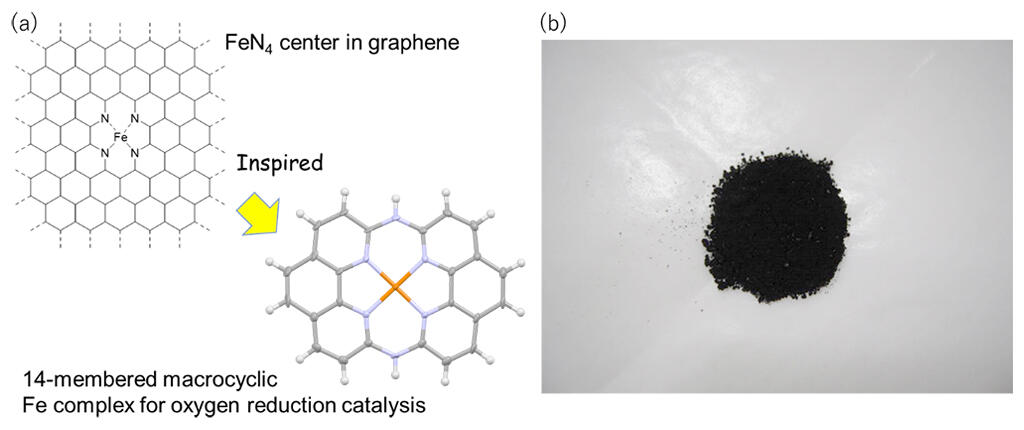The research group composed of Assistant Professor Yuta Nabae, Professor Teruaki Hayakawa, and others at the School of Materials and Chemical Technology, Department of Materials Science and Engineering, Tokyo Institute of Technology, in collaboration with Associate Professor Junya Ohyama of Kumamoto University, Lecturer Makoto Moriya of Shizuoka University, and Asahi Kasei Corporation, have succeeded in developing a novel substance that leads to non-platinization of fuel cells.
Vehicles equipped with fuel cells that produce electricity by chemically reacting hydrogen with oxygen do not emit greenhouse gases during power generation. However, in contemporary commercial vehicles, approximately 20-30 g of expensive and rare platinum is used as the catalyst inside the fuel cells, which has hindered their widespread adoption. Various metal complexes, such as Fe phthalocyanine (FePc), which is a cyclic compound in which a ligand (phthalocyanine) is bonded around inexpensive iron, have also been evaluated as alternative catalysts. However, practicable levels of stability have not been achieved in the operating environment of fuel cell, which contains an acidic electrolyte.
The research group investigated whether there is a method for synthetically producing a large amount of a structure similar to the active site of an iron-based heat-treated catalyst while improving the stability. Macrocyclic complexes, such as Fe phthalocyanine, can be synthesized in large quantities without high-temperature heat treatment. The majority of the known macrocyclic complexes contain iron atoms immobilized by 16 atoms surrounding them in a 16-membered ring.
In this study, the research group aimed to synthesize an aromatic 14-membered ring Fe complex having a slightly more compact structure, which immobilizes iron atoms using 14 surrounding atoms. To realize the idea of producing a 14-membered ring Fe complex and verifying its catalytic activity and stability, the group investigated a new method for synthesizing a 14-membered ring Fe complex. For the first time, they were able to synthesize such a complex at a high purity. Upon evaluating the oxygen-reduction catalytic activity of the prepared catalyst by a potential sweep test, the catalyst exhibited higher activity and durability compared to Fe phthalocyanine. To verify the durability of the catalyst in the acidic electrolyte, real-time analyses were performed to track the elution behavior of the iron ions. Results indicate that the 14-membered ring structure stabilized the iron atom as intended.
According to Assistant Professor Nabae, "Iron-based catalysts are attracting attention as alternatives for platinum catalysts for the full-scale adoption of solid polymer electrolyte fuel cells, but neither their catalytic activity nor their durability were practicable. In the future, intend to practically apply platinum-alternative catalysts by optimizing the structure around the 14-membered ring and improving the catalytic activity by approximately 30 times the current level."
■ Fe phthalocyanine: A compound having a structure in which an iron atom is introduced into the center of a cyclic compound called phthalocyanine, used for pigments, etc.
■ Macrocyclic complex: metal complexes in which the ligand portion has a cyclic structure and is relatively large. Complexes with phthalocyanine or porphyrin as a ligand are typical.

Credit: Tokyo Institute of Technology
■ Associated journal article can be found at the following link: Junya Ohyama, Makoto Moriya, Ryo Takahama, Kazuki Kamoi, Shin Kawashima, Ryoichi Kojima, Teruaki Hayakawa, and Yuta Nabae: High Durability of a 14-Membered Hexaaza Macrocyclic Fe Complex for an Acidic Oxygen Reduction Reaction Revealed by In Situ XAS Analysis, JACS Au 2021, 1, 10, 1798-1804
This article has been translated by JST with permission from The Science News Ltd.(https://sci-news.co.jp/). Unauthorized reproduction of the article and photographs is prohibited.




